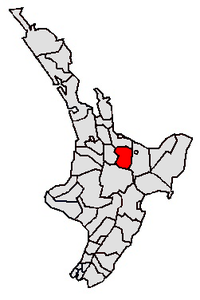Rotorua Lakes District or Rotorua District is a territorial authority district in the North Island of New Zealand. It has one urban area of significant size, the city of Rotorua. The district is governed by Rotorua Lakes Council, which is headquartered in Rotorua and is headed by a mayor. The district falls within two regional council areas, with the majority of the area and Rotorua city in the Bay of Plenty Region and the rest in the Waikato region.[3] Tania Tapsell has been the mayor of Rotorua since the 2022 local elections.
Rotorua Lakes District | |
|---|---|
 | |
 Rotorua Lakes, split by a regional boundary | |
| Coordinates: 38°13′48″S 176°16′41″E / 38.23°S 176.278°E | |
| Country | New Zealand |
| Regions |
|
| Wards | None |
| Main towns and settlements | Rotorua, Ngongotahā |
| Government | |
| • Mayor | Tania Tapsell |
| • Parliamentary electorate | Rotorua |
| • Territorial authority | Rotorua Lakes Council |
| Area | |
| • Land | 2,409.30 km2 (930.24 sq mi) |
| Population (June 2023)[2] | |
| • Total | 78,200 |
| Time zone | UTC+12 (NZST) |
| • Summer (DST) | UTC+13 (NZDT) |
| Postcode(s) | |
| Area code | 07 |
| Website | www |
History
Rotorua has an unusual history, as the town was built by the Government as a tourist destination in the 1880s.[4] Through the Rotorua Borough Act 1922, which achieved royal assent on 28 September 1922, the Rotorua Borough was formed.[5] The inaugural elections for mayor were held in February 1923 and Cecil Clinkard was successful.[6][7] In 1962, Rotorua was proclaimed a city.[8] In 1979, the status was changed to a district when Rotorua City and Rotorua County amalgamated.[9] The district council held its first meeting on 2 April 1979.[10] At the 27 November 2014 council meeting, it was decided to change the operating name of the council to Rotorua Lakes Council, while the official name would remain unchanged.[11] Since then, the district has been known as Rotorua Lakes[clarification needed] and the council's web domain changed from www.rdc.govt.nz to rotorualakescouncil.nz.
Geography
Rotorua Lakes covers 2,409 square kilometres (930 sq mi).[12] The district's area is 61.52% in the Bay of Plenty region and 38.48% in the Waikato region. Adjacent districts (in a clockwise direction starting in the north) are Western Bay of Plenty, Whakatāne, Taupō, and South Waikato.[13][14]
The Bay of Plenty portion of the district includes the settlements of Rotorua, Ngongotahā Valley, Mamaku, Hamurana, Mourea, Rotoiti Forest, Lake Rotoma, Lake Okareka, Lake Tarawera, Rerewhakaaitu, and Kaingaroa Forest. The Waikato portion includes the settlements of Waiotapu, Reporoa, Broadlands, Mihi, Waikite Valley, Ngakuru, and Ātiamuri.
Demographics
Rotorua District covers 2,409.30 km2 (930.24 sq mi)[1] and had an estimated population of 78,200 as of June 2023,[2] with a population density of 32 people per km2.
| Year | Pop. | ±% p.a. |
|---|---|---|
| 2006 | 65,901 | — |
| 2013 | 65,280 | −0.14% |
| 2018 | 71,877 | +1.94% |
| 2023 | 74,058 | +0.60% |
| Source: [15][16] | ||
| Ethnicity | Population |
|---|---|
| New Zealand European | 45,588 |
| Māori | 32,199 |
| Pasifika | 4,716 |
| Asian | 7,443 |
| MELAA | 513 |
| Other | 753 |
Rotorua District had a population of 74,058 in the 2023 New Zealand census, an increase of 2,181 people (3.0%) since the 2018 census, and an increase of 8,778 people (13.4%) since the 2013 census. There were 30,048 dwellings. The median age was 36.6 years (compared with 38.1 years nationally). There were 16,050 people (21.7%) aged under 15 years, 14,073 (19.0%) aged 15 to 29, 32,361 (43.7%) aged 30 to 64, and 11,574 (15.6%) aged 65 or older.[16]
Ethnicities were 61.6% European/Pākehā, 43.5% Māori, 6.4% Pasifika, 10.1% Asian, 0.7% Middle Eastern, Latin American and African New Zealanders, and 1.0% other. People may identify with more than one ethnicity.[16]
Rotorua District had a population of 71,877 at the 2018 New Zealand census. There were 25,056 households, comprising 35,148 males and 36,729 females, giving a sex ratio of 0.96 males per female.
The percentage of people born overseas was 17.8, compared with 27.1% nationally.
Although some people chose not to answer the census's question about religious affiliation, 49.9% had no religion, 35.0% were Christian, 3.1% had Māori religious beliefs, 1.8% were Hindu, 0.3% were Muslim, 0.5% were Buddhist and 2.5% had other religions.
Of those at least 15 years old, 9,876 (17.7%) people had a bachelor's or higher degree, and 10,434 (18.7%) people had no formal qualifications. The median income was $28,000, compared with $31,800 nationally. 7,122 people (12.8%) earned over $70,000 compared to 17.2% nationally. The employment status of those at least 15 was that 27,117 (48.6%) people were employed full-time, 8,541 (15.3%) were part-time, and 3,378 (6.1%) were unemployed.[15]
Local government
Local council
Every three years, a mayor and the district councillors are elected in local elections. In the most recent elections in 2022, Tania Tapsell was elected as mayor and ten councillors were returned. Rotorua Lakes uses the first-past-the-post (FPP) voting system and elects six councillors at-large, three for the Māori ward, and one for the rural ward.[17]
Coat of arms
|
Sister cities
Rotorua has four sister cities:[19]
References
External links
 Media related to Rotorua District at Wikimedia Commons
Media related to Rotorua District at Wikimedia Commons